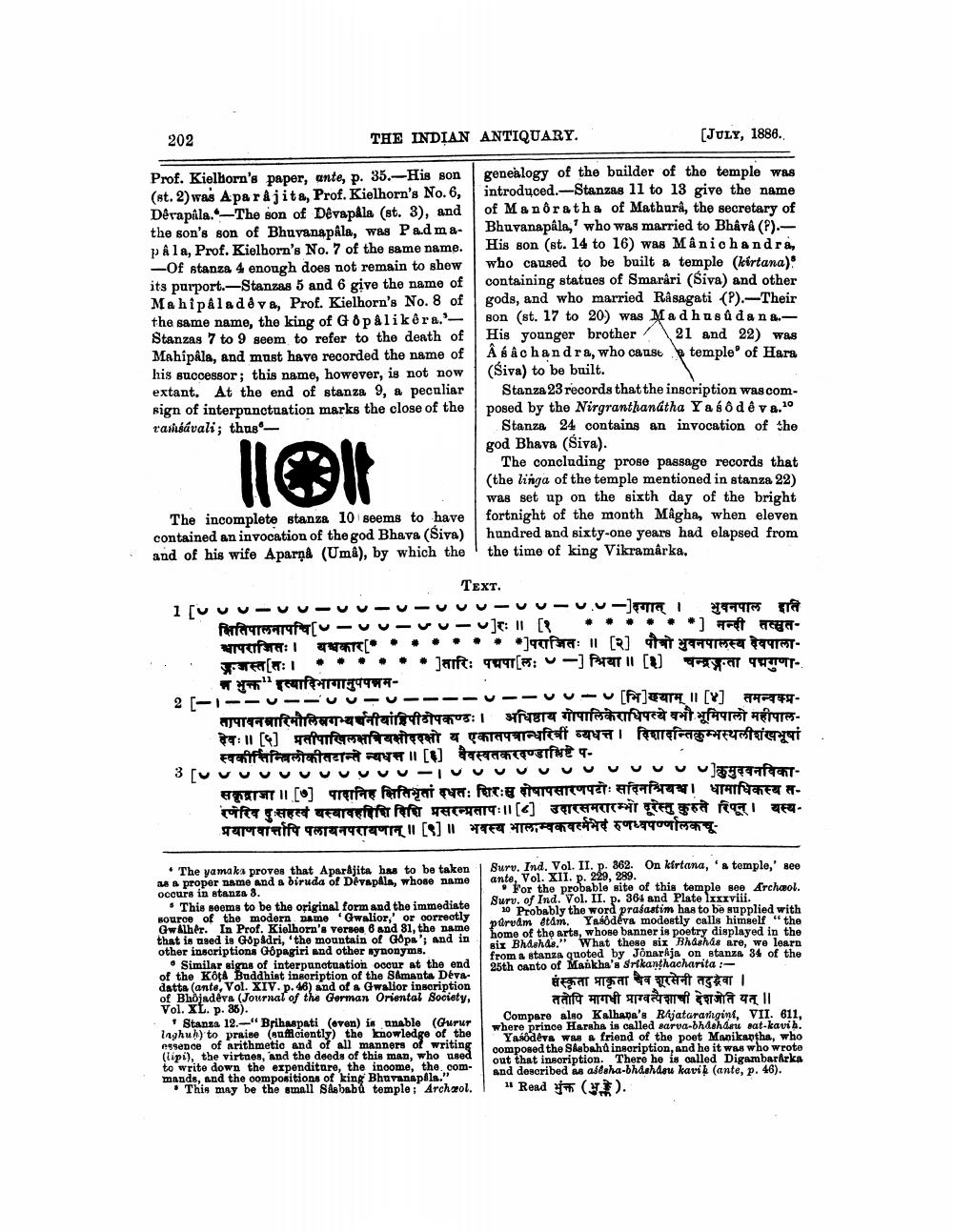________________
202
THE INDIAN ANTIQUARY.
(JULY, 1886.
Prof. Kielhorn's paper, ante, p. 35.-His son genealogy of the builder of the temple was (st. 2) was Aparajita, Prof. Kielhorn's No. 6, introduced.--Stanzas 11 to 13 give the name Dêrapala. The son of Devapála (st. 3), and of Mandratha of Mathara, the secretary of the son's son of Bhuvanapala, was Padma- Bhuvanapala,' who was married to Bhava ().pala, Prof. Kielhorn's No. 7 of the same name. His son (st. 14 to 16) was Mânio handra,
-Of stanza 4 enough does not remain to show who caused to be built a temple (Kirtana) its purport.-Stanzas 5 and 6 give the name of containing statues of Smarári (Siva) and other Mahipalad é ya, Prof. Kielhorn's No. 8 of gods, and who married Râsagati ().-Their the same name, the king of Gopalikêra.' son (st. 17 to 20) was Madhusudana. Stanzas 7 to 9 seem to refer to the death of His younger brother 21 and 22) was Mahipala, and must have recorded the name of A b â chandra, who caust temple of Hara his successor; this name, however, is not now (Śiva) to be built. extant. At the end of stanza 9, a peculiar Stanza 23 records that the inscription was comsign of interpunctuation marks the close of the posed by the Nirgranthanatha Ya God dva. rasisavali; thuse –
Stanza 24 contains an invocation of the god Bhava (Siva).
The concluding prose passage records that (the linga of the temple mentioned in stanza 22)
was set up on the sixth day of the bright The incomplete stanza 10 seems to have fortnight of the month Magha, when eleven contained an invocation of the god Bhava (Siva) | hundred and sixty-one years had elapsed from and of his wife Aparna (Uma), by which the the time of king Vikramárka.
TEXT. 1 [uuuuuuuuuuuuuuu-]TTEIT
forferfolu-uu-vu-Ulr: 1 [ . . . . ] roft - vrata: ......
II (RJ T EU TANTOT ... TUTTI
... jaft: 49[ES: - PUTII CU PT quarto " Far TT962 [-I--u--vu-u----U--uv-u[fr]11 [] THEY
तापावनबारिमौलिखगभ्यर्चनीयांडिपीठोपकण्ठः। अधिष्ठाय गोपालिकेराधिपत्ये वभौ भूमिपालो महीपालदेवः॥ [4] प्रतीपाखिलापियक्षीदवक्षो य एकातपत्रान्धरित्री व्यधत्त । दिशान्तिकुम्भस्थलीशंखभूषां
स्वकीसिन्विलोकीतटान्ते न्यधन ।। [१] वैवस्वतकरदण्डाभिष्टे प. 3 [uuuuuuuuuuu-IuuuuuuuuuuuuuuftTT 11 [O] Tref RTIT : for: STETTY:
Art - रणरिव दुःसहत्वं चस्वावहदिशि दिशि प्रसरन्प्रतापः।। [6] उदारसमरारम्भो दूरेस्तु कुरुते रिपून। यस्यप्रयाणवाापि पलायनपरावणान् ।। [१] ॥ भवस्य भालाम्बकवर्मभेदं रुणध्वपालकचू.
• The yamaks proves that Aparajita has to be taken | Suru. Ind. Vol. II. P. 362. On kirtana, 's temple,' see
proper name and a biruda of DevapAls, whose name ante, Vol. XII. p. 229, 289. occurs in stanza 8.
for the probable site of this temple see Archæol. . This seems to be the original form and the immediate
Surv. of Ind. Vol. II. p. 364 and Plate lxxxviii. source of the modern Dame "Gwalior,' or correctly
20 Probably the word prašastim has to be supplied with Gw Alher. In Prof. Kiellorn's verses 6 and 81, the name
purvam etam. Yasodēva modestly calls himself "the that is used is Gopadri, 'the mountain of Gops'; and in
home of the arts, whose banner is poetry displayed in the
sir Bhdeh48." other inscriptions Gopagiri and other synonyms.
What these six Bhashas are, we learn
from a stanza quoted by Jonarkja on stanza 34 of the • Similar signs of interpunctuation occur at the end
25th oanto of Mankha's Srikanthacharita :of the Kota Buddhist inscription of the Samanta Deva. datta (ante, Vol. XIV. p. 16) and of a Gwalior inscription
संस्कृता प्राकृता चैव शूरसेनी तदुद्भवा । of Bhojadeva (Journal of the German Oriental Society,
ततोपि मागधी प्राग्वत्पशाची देशजोत यत् ।। Vol. XL. p. 38). Stanza 12.-"Brihaspati (aven) in unable (Gurur
Compare also Kalhana's Rajatarangint, VII. 611, Inghuh) to praise (suficiently) the knowledge of the
where prince Harsha is called sarva-bhdah dan sat-kavih. essence of arithmetio and of all manners of writing
Yabaeva ww a friend of the poet Manikantha, who (lipi), the virtues, and the deeds of this man, who used
composed the Slabsha insoription, and he it was who wrote to write down the expenditure, the income, the com
out that insoription. There he is called DigambarArka mands, and the compositions of king Bhuvanapila."
and described is aléaha-bhdahden kavik (ante, p. 46). . This may be the small Sababu temple ; Archool. " Read (.1).




